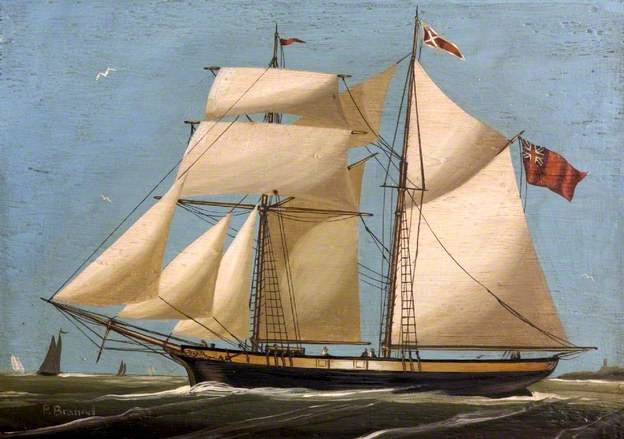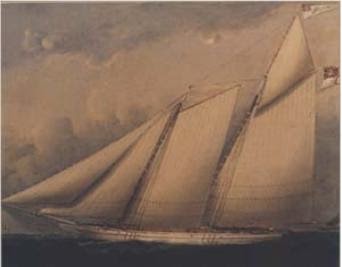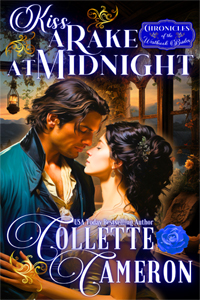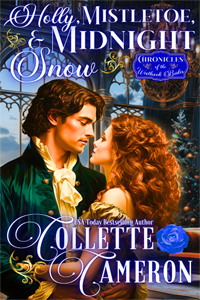Schooners of the Regency Era
By Regan Walker
My latest novel, Wind Raven, is a seafaring pirate Regency, much of which is set on a schooner in 1817. To set my scenes accurately, especially those in a storm, I had to know much about schooners of the period and their crews. I don’t have space today to share all of my research, but I thought to share enough about a schooner and its crew to give you a bit of an understanding.
The Ship
Though it can vary in size, generally a schooner is a smaller ship with only two or three decks and two or more masts (most often two) rigged with fore-and-aft sails. As their name indicates, schooners have the ability to glide across the water with superior speed. In Wind Raven the ship is a “topsail schooner,” meaning that the schooner has a square topsail on the foremast.
| Topsail Schooner |
The schooner’s sails run the length of the deck, enabling it to catch the wind at a closer angle and their placement allows greater maneuverability. The ship can thus move closer to the wind, almost directly into the wind, giving it power and speed. The origins of the design are unknown but hulls conforming to the concept were, by the late 18th century, popular both in Britain and America.
Initially built for trade around the coasts, larger ones could take on longer voyages. Schooners were very popular as slavers and small trading vessels because they were wicked fast and they could navigate along coasts and well up into rivers to do their trading. They were also very popular as raiders, blockaders and revenue cutters for the same reason. Wherever the raiders or slavers could go, another schooner could follow.
There are no floors, doors, stairs, walls or ceilings on a schooner (or any ship for that matter). Instead, there are decks, cabin doors, ladders, bulkheads and overheads. Schooners do not have crow’s nests either; they have crosstrees.
At the outset of the War of 1812, the British navy was the largest in the world with several hundred warships, whereas the American navy had no more than twenty. So the government commissioned private vessels to attack the British merchant fleet to disrupt their supply lines. Britain also had such vessels. These privateers were neither paid nor controlled by their respective governments, though if they had a “letter of marque,” privateers could operate within the law. In Wind Raven, the hero, Capt. Jean Nicholas Powell, was a privateer preying on the French during the wars with Napoleon, but by 1817 had resumed his role as a merchant captain.
| American Privateer Chasseur |
The schooners called the “Baltimore clipper ships” like the one pictured above were American privateers, designed for greater speed and maneuverability enabling them to slip through the British blockades. Their raked or slanted masts are one feature that identifies them. Traditional merchant ships averaged speeds of under 5 knots, whereas Baltimore clippers aimed at 9 knots or better (supposedly up to 20). In Wind Raven, it was one of those ships that Captain Powell coveted, which set him on a course for the heroine’s home port of Baltimore.
Both England and America had schooners in the War of 1812, some handed back and forth between the two countries. (The schooner Liverpool Packet(pictured below) based in Nova Scotia, captured fifty American vessels in the War of 1812. In turn, it was captured by American privateers, only to be recaptured by the British and returned to raiding American commerce.)
| Liverpool Packet Ship |
The Crew
The crew of a schooner could vary in size depending on the size of the schooner and how far it traveled. In Wind Raven, the schooner has a crew of thirty though you only meet some of them.
The captain would have responsibility for overall leadership of the ship. He gave orders to the officers, kept the ship’s log, charted the course and oversaw the crew. He also usually did the doctoring. He might have a book that would allow him to look up the symptoms and then give the recommended treatment out of a pre-packaged “medical kit” that could also be bought, ready-made. Of course it contained items like mercury, antimony, asafetida and calomel, but that is what they had then.
The officers did not man the tiller; they had other duties (charting, navigating, log keeping, overseeing the crew, giving the orders about sail trim, sighting the shore or stars. A senior crewmember would typically serve as the helmsman. An “able seaman” could also furl sails, reef sails and take the helm, as old Nate does in Wind Raven.
On a big enough ship, the captain might have a steward who would oversee the cooking of the captain’s food in the galley, keep the key to the captain’s food and wine supply and serve as a gentleman’s valet and table servant. However, on smaller ships, like the schooner in Wind Raven, the captain might only have a cabin boy to fetch his meals from the galley and deliver them to his cabin.
Not all merchant schooners carried guns (generally they are called guns not cannon, because they are fixed). However, privateers (and pirates) certainly did. The gunner was in charge of maintaining the guns, the shot and other projectiles, the gunpowder, the wads and the slow match. There was a lot of maintenance required and all this equipment had to stay dry in a constantly leaking wooden ship.
The bosun (bos’n) would be in charge of the ship’s rigging, cordage, anchors, spars and physical repairs to the rig. There would also be a sailmaker, who made, altered and repaired sails. The carpenter had responsibility for hull and wood maintenance and general repairs on the ship.
Of course, there would be a cook. In Wind Raven, he’s a red haired Irishman named McGinnes who tells fairy stories to the crew and seems to think the heroine is the leanan sídhe, a fairy who seeks the love of mortal men.
As to where the crew slept aboard the schooner, it depended on rank. The higher the rank, the farther aft the crewmember lived. The captain’s cabin would be in the back of the ship (aft), where it’s the driest and there is the least amount of pitch and roll in rough weather. Also in the aft would be small cabins for other officers and “standing officers” like the carpenter, the gunner, etc. Forward, it’s wet, leaky and uncomfortably “lively.” That’s where they put the animals and the low-ranking ordinary crew.
And the Blurb:
Ordered by the Prince Regent into the Caribbean, English sea captain and former privateer Jean Nicholas Powell has no time for women onboard the Wind Raven, especially not Tara McConnell. The impudent American forced herself aboard, and so she’ll get more than she bargained for: Instead of a direct sail to Baltimore, she’ll join their quest to investigate a rampaging pirate, the infamous Roberto Cofresi.
But the hoyden thinks she can crew with his men, and though he bans her from the rigging, Nick is captivated watching her lithe, luscious movements on deck. Facing high seas, storms, cutthroats and the endless unknown, he must protect his ship, his passenger, his crew. But on this voyage, with this woman, there is a greater danger: to his heart.
Buy link for Wind Raven on Amazon:
Contact Regan
Regan’s website: http://www.reganwalkerauthor.com/
Regan’s blog: http://reganromancereview.blogspot.com/
Twitter: @RegansReview (https://twitter.com/RegansReview)
Facebook: http://www.facebook.com/regan.walker.104
Thanks so much for visiting today, Regan. This article was fascinating!













